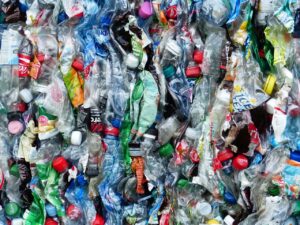The UK Plastic Packaging Tax: One Year Later
The 1st of April 2022 saw a new legislation come into effect, the UK Plastic Packaging Tax. This extra tax was introduced in a bid to combat the sheer amount of plastic in our world and encourage businesses to use recycled plastics or try alternative, more sustainable solutions.
It’s no secret that the material is incredibly harmful to the environment. A shocking 12-14 million tonnes of plastic ends up in our oceans yearly, accounting for 80% of marine debris. This statistic is just the tip of the melting iceberg and it’s clear that we desperately need to reduce the amount ending up in landfills and incinerators.
It’s now been over a year since the tax was introduced and many have queried its success. Has it reduced the amount of virgin plastic in circulation, or is it just being seen as the new cost of doing business for UK companies?
Keep reading as we dive into the UK Plastic Packaging tax one year on.
What Is the UK Plastic Packaging Tax?
First off, we’ll delve into a quick recap of the UK’s Plastic Packaging tax. This new charge is aimed at the manufacture and importation of plastic packaging components that contain less than 30% recycled plastic. Eligible businesses must submit quarterly returns to HMRC and provide details on weights and materials. However, those that import less than 10 tonnes of plastic packaging over a year are exempt.
The tax started off at a rate of £200 per tonne and increased to £210.82 per tonne from April 2023.
Has the UK’s Plastic Packaging Tax Been Successful?
The premise of PPT seemed rather simple. Those that used more virgin plastics in their operations were to pay more, which should act as an incentive to seek out more sustainable solutions, but has this been the case?
40% of reported plastic contained at least 30% recycled content
According to HMRC’s policy paper, out of the total plastic packaging manufactured in and imported into the UK, 39% was declared as taxable. Of the remaining 61% declared, 40% was exempt as it contained over 30% recycled content, 21% was either exported, intended for export or converted and less than 1% was exempt as it was used for the immediate packaging of human medicines. Of all the plastic packaging reported, 52% was manufactured in the UK and 48% was imported.
Revenue estimates of £235 million exceeded
The paper further reported that the tax was estimated to generate £235 million in its first year and see around 20,000 businesses sign up. As of December 2022, only 3559 companies registered, but over £200 million in revenue was reported. By the end of the 2022 – 2023 financial year, 4,142 businesses registered and the PPT receipts collected by HMRC totalled a staggering £276 million.
Has the Plastic Packaging Tax Failed?
Where 40% of plastics containing at least 30% recycled content may sound like a good effort, HMRC’s original estimate was exceeded by a considerable amount and significantly fewer businesses registered. To many, this suggests that the tax has failed, as if the aim had been met, tax receipts should have been significantly reduced.
To put it into context, the original estimate of £230 million in revenue equates to a staggering 1.15 MT of plastic packaging that does not contain at least 30% recycled content.
Why Has the Plastic Packaging Tax Not Been Completely Successful?
There are a number of reasons why PPT hasn’t been a complete triumph. For starters, it’s been suggested that the tax just isn’t high enough, as many larger companies are simply seeing it as the cost of doing business. It’s also been said that the required threshold for recycled content needs to be much higher, too and independent auditing needs to be carried out on companies’ returns to ensure compliance.
Missed funding opportunities
At present, the revenue raised for PPT goes straight to the treasury. Where this revenue may be seen by the Government as a welcome help with the cost of living crisis, it poses the question of whether this is the best possible use for the money. Instead, many believe that the money raised from PPT should be used to invest in recycling capabilities and improve the country’s ability to recycle plastic.
Increased demand, increased recycled plastic need
The Government’s aim was to provide an economic incentive for businesses to use recycled plastic in their manufacturing processes, which will result in a greater demand. The theory was that this would also stimulate increased levels of recycling and collection of plastic waste, reducing the amount ending up in landfills or incinerators.
Where it has certainly increased investments and demand for recycled plastics, there’s now the growing concern that there’s not enough recycled plastic to meet demand. The majority of the demand is now being met by suppliers overseas as the UK lacks the required reprocessing capacity.
What’s Next for The Plastic Packaging Tax?
The UK Government has announced its consultation on reforming PPT to encourage investments in chemical recycling. This is incredibly important as without this, it’s highly unlikely that flexible food-contact packaging will be able to meet the 30% minimum recycled content required to avoid PPT.
With the Government’s proposals to introduce recyclable plastic film and flexible packaging household collections set to launch in March 2027, it’s clear that mechanical recycling can’t be the only solution. Chemical recycling processes such as pyrolysis, gasification, hydro-cracking and depolymerisation can deal with much more complex plastic waste streams such as films and laminates and are a more stable and secure mass outlet that needs to be explored as soon as possible.
It’s important to understand that the environmental results of PPT were never going to be instant, but it does form an important framework for the future. Together with the Deposit Return Scheme for drinks containers and extended producer responsibility (EPR), it will play its part in the overall goal of reducing plastic in landfills and overall carbon emissions.
Looking for a sustainable alternative for your business’s packaging? Browse our plastic-free range today and get free UK mainland delivery with no minimum order value.





